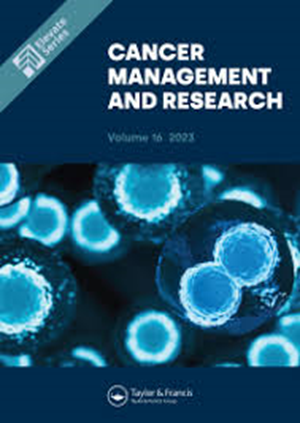Key Cell-in-Cell Related Genes are Identified by Bioinformatics and Experiments in Glioblastoma
IF 2.6
4区 医学
Q3 ONCOLOGY
引用次数: 0
Abstract
Purpose: This study aimed to explore the roles of cell-in-cell (CIC)-related genes in glioblastoma (GBM) using bioinformatics and experimental strategies.Patients and Methods: The ssGSEA algorithm was used to calculate the CIC score for each patient. Subsequently, differentially expressed genes (DEGs) between the CIClow and CIChigh groups and between the tumor and control samples were screened using the limma R package. Key CIC-related genes (CICRGs) were further filtered using univariate Cox and LASSO analyses, followed by the construction of a CIC-related risk score model. The performance of the risk score model in predicting GBM prognosis was evaluated using ROC curves and an external validation cohort. Moreover, their location and differentiation trajectory in GBM were analyzed at the single-cell level using the Seurat R package. Finally, the expression of key CICRGs in clinical samples was examined by qPCR.
Results: In the current study, we found that CIC scorelow group had a significantly better survival in the TCGA-GBM cohort, supporting the important role of CICRGs in GBM. Using univariate Cox and LASSO analyses, PTX3, TIMP1, IGFBP2, SNCAIP, LOXL1, SLC47A2, and LGALS3 were identified as key CICRGs. Based on this data, a CIC-related prognostic risk score model was built using the TCGA-GBM cohort and validated in the CGGA-GBM cohort. Further mechanistic analyses showed that the CIC-related risk score is closely related to immune and inflammatory responses. Interestingly, at the single-cell level, key CICRGs were expressed in the neurons and myeloids of tumor tissues and exhibited unique temporal dynamics of expression changes. Finally, the expression of key CICRGs was validated by qPCR using clinical samples from GBM patients.
Conclusion: We identified novel CIC-related genes and built a reliable prognostic prediction model for GBM, which will provide further basic clues for studying the exact molecular mechanisms of GBM pathogenesis from a CIC perspective.
Keywords: glioblastoma, bioinformatics, cell-in-cell, prognosis
通过生物信息学和实验发现胶质母细胞瘤中细胞内相关的关键基因
目的:本研究旨在利用生物信息学和实验策略探索胶质母细胞瘤(GBM)中细胞内(CIC)相关基因的作用:采用ssGSEA算法计算每位患者的CIC得分。随后,使用 limma R 软件包筛选 CIC 低组和 CIC 高组之间以及肿瘤样本和对照样本之间的差异表达基因(DEGs)。利用单变量 Cox 分析和 LASSO 分析进一步筛选关键的 CIC 相关基因(CICRGs),然后构建 CIC 相关风险评分模型。利用 ROC 曲线和外部验证队列评估了风险评分模型在预测 GBM 预后方面的性能。此外,还使用 Seurat R 软件包在单细胞水平上分析了它们在 GBM 中的位置和分化轨迹。最后,通过 qPCR 检测了关键 CICRGs 在临床样本中的表达情况:在本研究中,我们发现 CIC scorelow 组在 TCGA-GBM 队列中的生存率明显更高,这支持了 CICRGs 在 GBM 中的重要作用。通过单变量 Cox 和 LASSO 分析,我们发现 PTX3、TIMP1、IGFBP2、SNCAIP、LOXL1、SLC47A2 和 LGALS3 是关键的 CICRGs。基于这些数据,利用 TCGA-GBM 队列建立了 CIC 相关预后风险评分模型,并在 CGGA-GBM 队列中进行了验证。进一步的机理分析表明,CIC 相关风险评分与免疫和炎症反应密切相关。有趣的是,在单细胞水平上,关键的 CICRGs 在肿瘤组织的神经元和骨髓中表达,并表现出独特的表达时间动态变化。最后,利用 GBM 患者的临床样本通过 qPCR 验证了关键 CICRGs 的表达:我们发现了新的 CIC 相关基因,并建立了可靠的 GBM 预后预测模型,这将为从 CIC 角度研究 GBM 发病的确切分子机制提供进一步的基础线索。
本文章由计算机程序翻译,如有差异,请以英文原文为准。
求助全文
约1分钟内获得全文
求助全文
来源期刊

Cancer Management and Research
Medicine-Oncology
CiteScore
7.40
自引率
0.00%
发文量
448
审稿时长
16 weeks
期刊介绍:
Cancer Management and Research is an international, peer reviewed, open access journal focusing on cancer research and the optimal use of preventative and integrated treatment interventions to achieve improved outcomes, enhanced survival, and quality of life for cancer patients. Specific topics covered in the journal include:
◦Epidemiology, detection and screening
◦Cellular research and biomarkers
◦Identification of biotargets and agents with novel mechanisms of action
◦Optimal clinical use of existing anticancer agents, including combination therapies
◦Radiation and surgery
◦Palliative care
◦Patient adherence, quality of life, satisfaction
The journal welcomes submitted papers covering original research, basic science, clinical & epidemiological studies, reviews & evaluations, guidelines, expert opinion and commentary, and case series that shed novel insights on a disease or disease subtype.
 求助内容:
求助内容: 应助结果提醒方式:
应助结果提醒方式:


